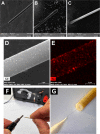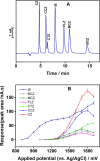Electrochemical HPLC Determination of Piperazine Antihistamine Drugs Employing a Spark-Generated Nickel Oxide Nanoparticle-Modified Carbon Fiber Microelectrode
- PMID: 38313503
- PMCID: PMC10831984
- DOI: 10.1021/acsomega.3c09474
Electrochemical HPLC Determination of Piperazine Antihistamine Drugs Employing a Spark-Generated Nickel Oxide Nanoparticle-Modified Carbon Fiber Microelectrode
Abstract
In this work, we demonstrate a sensitive high-performance liquid chromatography (HPLC) method for the determination of piperazine antihistamine drugs employing innovative electrochemical detection based on a spark-generated nickel oxide nanoparticle-modified carbon fiber microelectrode built into a miniaturized electrochemical detector. The direct carbon fiber-to-nickel plate electrode spark discharge, carried at 0.8 kV DC, with the nickel electrode connected to the negative pole of the high-voltage power supply, provides extremely fast (1 s) in situ tailoring of the carbon fiber microelectrode surface by nickel oxide nanoparticles. It has been found that nickel oxide nanoparticles exhibit an electrocatalytic effect toward the piperazine moiety electrooxidation process, as confirmed by voltammetric experiments, revealing the shift in the peak potential from 1.25 to 1.09 V versus Ag/AgCl. Cetirizine, cyclizine, chlorcyclizine, flunarizine, meclizine, and buclizine were selected as sample piperazine antihistamine drugs, while diclofenac served as an internal standard. The isocratic reversed-phase separation of the above set was achieved within 15 min using an ARION-CN 3 μm column with a binary mobile phase consisting of 50 mM phosphate buffer (pH 3) and methanol (45/55, v/v). The limits of detection (LOD) were within the range of 3.8-120 nM (for cyclizine and buclizine) at E = +1500 mV (vs Ag/AgCl), while the response was linear within the concentration range measured up to 5 μmol L-1. The method was successfully applied to the determination of piperazine antihistamine drugs in spiked plasma samples.
© 2024 The Authors. Published by American Chemical Society.
Conflict of interest statement
The authors declare no competing financial interest.
Figures





Similar articles
-
HPLC-ED of low-molecular weight brominated phenols and tetrabromobisphenol A using pretreated carbon fiber microelectrode.Talanta. 2014 May;122:115-21. doi: 10.1016/j.talanta.2014.01.013. Epub 2014 Jan 31. Talanta. 2014. PMID: 24720971
-
A glassy carbon electrode modified with a composite consisting of gold nanoparticle, reduced graphene oxide and poly(L-arginine) for simultaneous voltammetric determination of dopamine, serotonin and L-tryptophan.Mikrochim Acta. 2018 Aug 30;185(9):439. doi: 10.1007/s00604-018-2979-z. Mikrochim Acta. 2018. PMID: 30167981
-
A comparison of electrochemically pre-treated and spark-platinized carbon fiber microelectrode. Measurement of 8-oxo-7,8-dihydro-2'-deoxyguanosine in human urine and plasma.Anal Chim Acta. 2016 Sep 7;935:82-9. doi: 10.1016/j.aca.2016.06.044. Epub 2016 Jun 30. Anal Chim Acta. 2016. PMID: 27543016
-
High perfomance liquid chromatography in pharmaceutical analyses.Bosn J Basic Med Sci. 2004 May;4(2):5-9. doi: 10.17305/bjbms.2004.3405. Bosn J Basic Med Sci. 2004. PMID: 15629016 Free PMC article.
-
DNA/nickel oxide nanoparticles/osmium(III)-complex modified electrode toward selective oxidation of l-cysteine and simultaneous detection of l-cysteine and homocysteine.Bioelectrochemistry. 2012 Aug;86:9-21. doi: 10.1016/j.bioelechem.2011.12.013. Epub 2012 Jan 14. Bioelectrochemistry. 2012. PMID: 22296821
References
-
- Mahdy A. M.; Webster N. R. Histamine and antihistamines. Anaesth. Intensive Care Med. 2017, 18 (4), 210–215. 10.1016/j.mpaic.2017.01.007. - DOI
LinkOut - more resources
Full Text Sources
